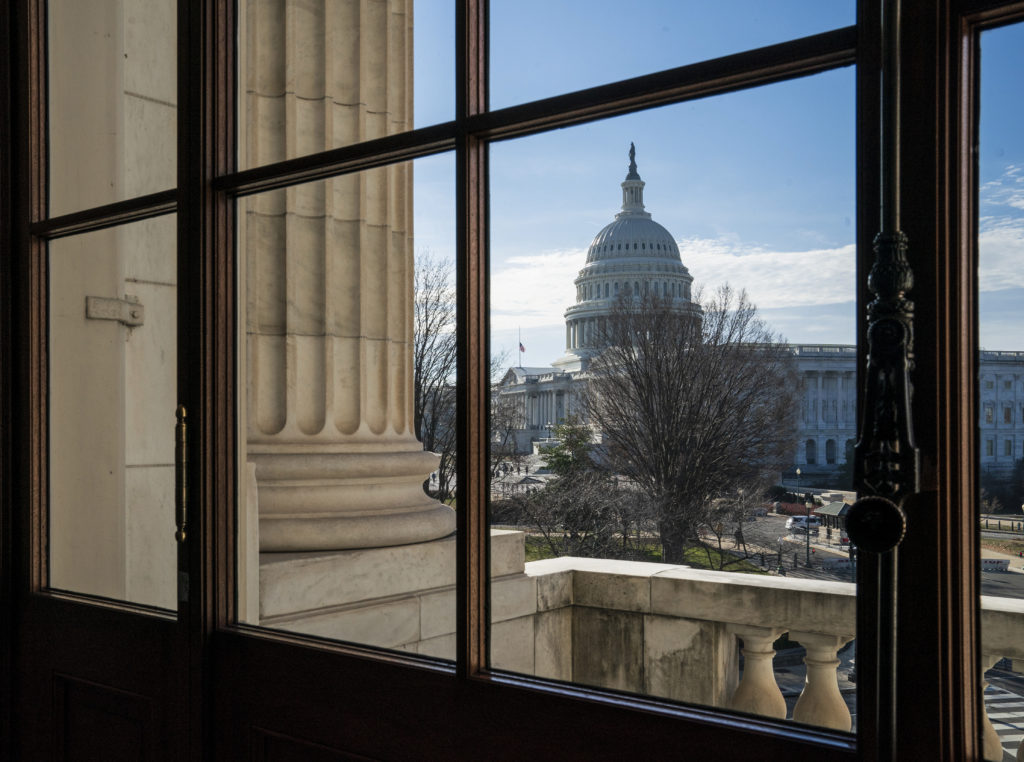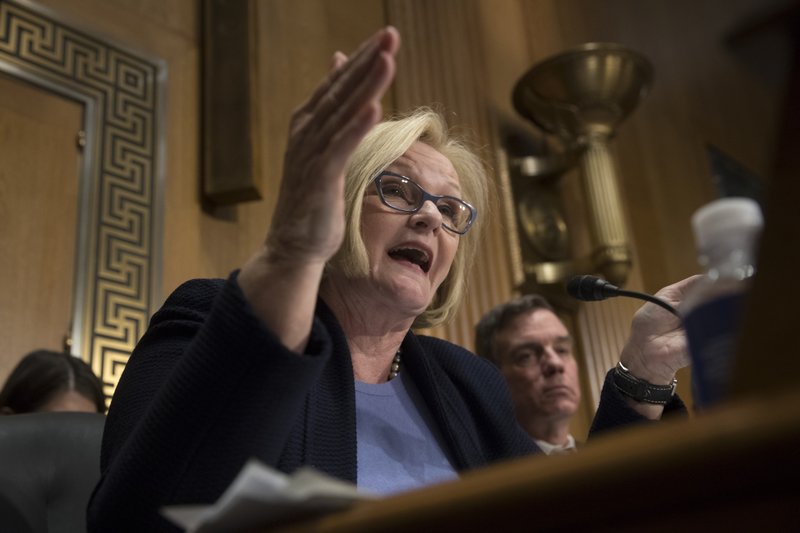No solution to shutdown in sight before Dems take House

The partial government shutdown will almost certainly be handed off to a divided government to solve in the new year — the first big confrontation between President Donald Trump and newly empowered Democrats — as agreement eludes Washington in the waning days of the Republican monopoly on power. Now nearly a week old, the impasse is idling hundreds of thousands of federal workers and beginning to pinch citizens who count on varied public services. Gates are closed at some national parks, the government won’t issue new federal flood insurance policies and in New York, the chief judge of Manhattan federal courts suspended work on civil cases involving U.S. government lawyers, including several civil lawsuits in which Trump himself is a defendant. Congress is closing out the week without a resolution in sight over the issue holding up an agreement — Trump’s demand for money to build a border wall with Mexico and Democrats’ refusal to give him what he wants. That sets up a struggle upfront when Democrats take control of the House on Jan. 3. Trump raised the stakes on Friday, reissuing threats to shut the U.S.-Mexico border to pressure Congress to fund the wall and to cease aid to three Central American countries from which many migrants have fled. The president also has signaled he welcomes the fight as he heads toward his own bid for re-election in 2020, tweeting Thursday evening that Democrats may be able to block him now, “but we have the issue, Border Security. 2020!” With another long holiday weekend coming, just days before House Republicans relinquish control, there is little expectation of a quick fix. “We are far apart,” White House press secretary Sarah Sanders told CBS on Friday, claiming of Democrats, “They’ve left the table all together.” House Democratic leader Nancy Pelosi has vowed to pass legislation as soon as she takes the gavel, which is expected when the new Congress convenes, to reopen the nine shuttered departments and dozens of agencies now hit by the partial shutdown. “If they can’t do it before Jan. 3, then we will do it,” said Rep. Jim McGovern, D-Mass., incoming chairman of the Rules Committee. “We’re going to do the responsible thing. We’re going to behave like adults and do our job.” But even that may be difficult without a compromise because the Senate will remain in Republican hands and Trump’s signature will be needed to turn any bill into law. Negotiations continue between Democrats and Republicans on Capitol Hill, but there’s only so much Congress can do without the president. Trump is not budging, having panned Democratic offers to keep money at current levels — $1.3 billion for border fencing, but not the wall. Senate Republicans approved that compromise in an earlier bill with Democrats but now say they won’t be voting on any more unless something is agreed to by all sides, including Trump. “I think it’s obvious that until the president decides he can sign something — or something is presented to him — that we are where we are,” said Sen. Pat Roberts, R-Kan., who opened the Senate on Thursday for a session that only lasted minutes. “Call it anything,” he added, “barrier, fence, I won’t say the ‘w’ word.” Trump long promised that Mexico would pay for the wall, but Mexico refuses to do so. Federal workers and contractors forced to stay home or work without pay are experiencing mounting stress from the impasse. As the partial shutdown stretched toward a second week, Ethan James, 21, a minimum-wage contractor sidelined from his job as an office worker at the Interior Department, wondered if he’d be able to make his rent. Contractors, unlike most federal employees, may never get back pay for being idled. “I’m getting nervous,” he said. “I live check to check right now.” For those without a financial cushion, even a few days of lost wages during the shutdown could have dire consequences. Roughly federal 420,000 workers were deemed essential and are working unpaid, unable to take any sick days or vacation. An additional 380,000 are staying home without pay. Like James, Mary Morrow, a components engineer on contract for NASA, is in a predicament. In addition to caring for a family largely on her own, she’s got a mortgage. “I have three teenage boys, it’s near Christmas time and we just spent money, there are credit card bills and normal bills and it’s really nerve-wracking,” she said. “It’s scary.” Steve Reaves, president of Federal Emergency Management Agency union, said the shutdown could have consequences that stretch beyond a temporary suspension of salary. Many federal government jobs require a security clearance, he said, and missed mortgage payments or deepening debt could hurt their clearance. David Dollard, a Federal Bureau of Prisons employee and chief steward for the American Federation of Government Employees Local 709 union in Colorado, said at least two agency employees lost their homes after the 2013 shutdown suspended their salaries. Bureau of Prisons employees are considered essential, and must work without pay. The agency is already understaffed, Dollard said. Shutdown conditions make everything worse. “You start out at $44,000 a year, there’s not much room for anything else as far saving money for the next government shutdown, so it puts staff in a very hard situation,” he said. “We’ve got single fathers who have child support, alimony. It’s very hard to figure out what you’re going to do.” Candice Nesbitt, 51, has worked for 1½ years for the U.S. Coast Guard, the only branch of the military affected by the shutdown. About 44,000 Coast Guard employees are working this week without pay; 6,000, including Nesbitt, have been furloughed. Nesbitt worked for a contractor but took a pay cut in exchange for the stability of a government job. She has a mortgage, is the guardian of her special needs, 5-year-old grandson, and makes about $45,000 a year, she said. Any lapse in payment could plunge her into debt. “It shakes me to the core,” she
Vulnerable Dems lay low as town hall angst rages

From Montana to West Virginia, the nation’s most vulnerable Senate Democrats are avoiding town hall meetings as their Republican counterparts get pummeled by an energized electorate frustrated with President Donald Trump‘s early agenda. Some Democrats prefer to connect with constituents over the telephone or using social media. Others are meeting voters in controlled environments with limited opportunities to ask questions. But few of the 10 Democratic senators facing re-election next year in states carried by Trump have scheduled in-person town hall meetings during this week’s congressional recess. Missouri Sen. Claire McCaskill declined an invitation to attend a town hall organized by a group called Kansas City Indivisible this weekend, deciding to send a staff member in her place. The two-term senator, up for re-election next year in a state Trump won by nearly 19 percentage points, is scheduled to chat with voters next week on Facebook Live. “Seems to me that all these members of Congress are afraid to face their constituents,” said Hillary Shields, a volunteer organizer with the Kansas City group. The cautious approach comes as Senate Democrats work to limit risks ahead of a challenging 2018 election season. After claiming the Senate majority in 2014, Republicans could win a filibuster-proof 60-vote Senate majority next year in an election in which Democrats are defending 25 seats (23 held by Democrats, two by independents), 10 of them in states carried by Trump. The GOP has a 52-48 edge in the Senate. There are no easy answers for Democrats like McCaskill, pushed to stand up to the Republican president by their liberal base and pulled to cooperate with the GOP by independents and moderates. McCaskill’s office noted she spent part of this week touring the U.S.-Mexico border and planned to host town halls later in the year. The political pressure is particularly intense for West Virginia Sen. Joe Manchin and North Dakota Sen. Heidi Heitkamp, Democrats whose states backed Trump by an average of 39 percentage points in November. Both have avoided formal town halls this week, but Heitkamp’s office said she participated in a discussion about flood issues with constituents in northeastern North Dakota and attended a subsequent ribbon-cutting on Thursday. She planned to tour a local National Weather Service office on Friday. Manchin’s office reported an equally busy schedule, but his constituents said he’s been hard to find this week. They’ve scheduled a protest outside the Democratic senator’s Charleston office on Friday to demand more access, according to Cathy Kunkel, an energy consultant who helped plan the protest. “Here we are, and we’d like a town hall meeting,” Kunkel said. “His constituents have a lot of questions. This is the first recess of the new Congress in the Trump administration.” As skittish Democrats dodge, many Republicans face an outpouring of anger in public meetings across the nation from constituents fired up over Trump’s first steps as president. Republicans like Senate Majority Leader Mitch McConnell and Arkansas Sen. Tom Cotton have been yelled at, heckled and booed in recent days. Some Republicans have avoided such confrontations. Texas Rep. Louie Gohmert evoked the near-fatal shooting of former Rep. Gabrielle Giffords to explain why he’s only holding telephone town halls. Giffords on Thursday urged members of Congress to “have some courage” and face their constituents. Yet few vulnerable Senate Democrats are expected to do so in settings that allow for unscripted questions. In Montana, where Trump prevailed by 20 percentage points, Sen. Jon Tester made several public appearances this week, but he did not advertise any of them as town halls. He answered questions about Scott Pruitt, Trump’s new chief of the Environmental Protection Agency, at one event about climate change, said spokeswoman Marnee Banks. In Pennsylvania, a spokeswoman for Sen. Bob Casey said he would host a town hall in early March, but the details hadn’t yet been set. In Florida, Sen. Bill Nelson addressed students at two Thursday appearances focused on education. And in Ohio, Sen. Sherrod Brown “has participated in several telephone conference calls recently” and his office “emailed surveys out to constituents” to gauge their priorities, said spokeswoman Jennifer Donohue. For now, protesters’ angst is largely focused on Republicans. But only a few weeks ago, Democrats including Senate Minority Leader Chuck Schumer and liberal heroine Massachusetts Sen. Elizabeth Warren faced a sharp rebuke for backing one of Trump’s Cabinet picks. “Grassroots Democrats won’t be shy about challenging their own leaders if they sense a whiff of cooperation with the Trump agenda,” said Ben Wikler, Washington director for the liberal group MoveOn.org. It’s unclear if they’ll get the chance with certain Senate Democrats, however. Shields noted that McCaskill made time to visit the Mexican border: “We’d like to have her back in Missouri.” Republished with permission of The Associated Press.


